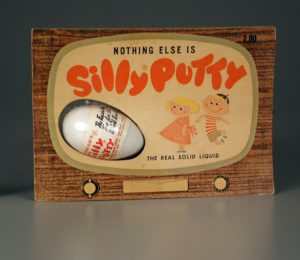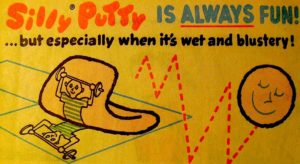
WWII brought about shortages of many basic commodities. One of these was rubber. Rubber was needed for military purposes, and there wasn’t enough of it.
A Scottish engineer named James Wright was looking for a man-made rubber substiitute. He was trying all sorts of mixtures of chemical compounds at the General Electric laboratory in New Haven, Connecticut.
Wright combined boric acid and silicone oil in one experiment. To his delight, it polymerized into a rubbery substance! He excitedly shared his creation with his employers and they began sending samples to other engineers all over the world, looking for a proposed use of the hard-won artificial rubber.
The results were silence. Not one practical idea for the bouncing putty emerged from the educated minds.
Nobody could think of what you could use the rubbery blobs for, but all enjoyed playing with them very much.
Peter Hodgson, an unemployed advertising man, was the man behind the marketing of Silly Putty. Hodgson had marketed the bouncing putty for a New Haven toy store. It sold well. But the store’s owner decided not to market it any more for some strange reason. So he borrowed some cash and purchased a large quantity of the goo from GE for $150. He also purchased a bunch of little plastic eggs and put a dollop of the putty in each one. He sold them for a buck a pop.
At the New York International Toy Fair in 1950, he introduced Silly Putty to the world. It was well received, and sales were steady, but not spectacular.
Then, in August, Silly Putty received a boost similar to the one Yours Truly was fortunate to get earlier this year with the mention on CBS’s The Early Show. In Hodgson’s case, it was an ad in The New Yorker extolling the bouncy putty. Within three days, he had received a quarter of a million orders!

Then, the Korean conflict almost killed his thriving business. Government restrictions on silicone usage in 1951 forced him to carefully parcel out 1500 lbs. of Silly Putty. The next year, restrictions were lifted, and production ramped back up.
Silly Putty appeared in television commercials beginning in the 60’s, and that caused sales to climb ever higher.
Interestingly, Silly Putty saw the demographic of its customers reverse early in the game. When it was introduced, it was a novelty that appealed to grownups, accounting for 80% if its sales. But within five years, the buyers were 80% children! The ratio has stayed there ever since.
Silly Putty could bounce. It could stretch. It could flow slowly like a thick liquid. And, of course, it could pick up ink, as in images from comic books and newspapers.
It was (and still is) small, cheap, and perfect for lots of imaginative uses. It’s also completely useless for any practical purpose other than entertainment. But it’s absolutely perfect for that.
And today, an old goat who just turned 48 keeps a container of Silly Putty in his desk drawer to play with during conference calls and the like.
It’s as much fun now as it was about 1967.